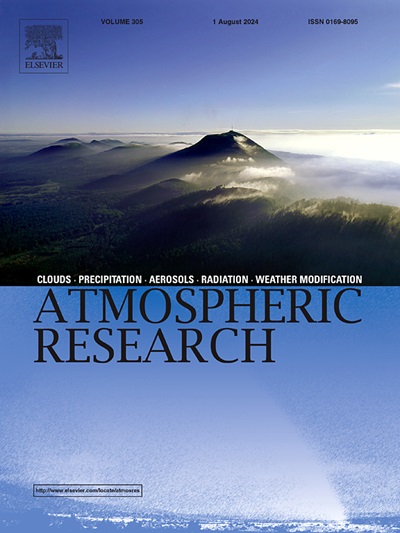Global future heat stress projections: Regional variations of Humidex changes from high-resolution CMIP6 models
IF 4.4
2区 地球科学
Q1 METEOROLOGY & ATMOSPHERIC SCIENCES
引用次数: 0
Abstract
This study investigates future projections of the extreme Humidex, a compound index integrating air temperature and relative humidity, as an indicator of heat stress under two Shared Socioeconomic Pathways (SSP1–2.6 and SSP5–8.5). Using multi-model ensemble simulations from 15 high-resolution CMIP6 models, we examine seasonal variations in the extreme Humidex at both global and regional scales across 21 land regions. The historical simulations from CMIP6 models were validated using ERA5 observational data, ensuring reliability and accuracy in model projections. Additionally, the climatology of Humidex values derived from MME simulations was compared with the climatology of the Heat Index obtained from MME simulations, revealing consistency between the two heat stress indicators. To quantify heat-related hazards, we calculate the number of seasonal Dangerous Humidex Days (DHDs). Furthermore, we assess the relative contributions of air temperature and relative humidity to projected changes in the extreme Humidex. The results reveal a marked intensification of heat stress under SSP5–8.5, with late-century (2080–2100) increases in the extreme Humidex reaching approximately 5 to 9 °C across most land regions, compared to around 1.5 to 3.5 °C under SSP1–2.6. The JJA season exhibits the greatest intensification, particularly over Eastern North America and Northern Asia. On average, DJF shows a 2.78-fold increase in Humidex anomalies, while JJA demonstrates an even larger amplification of approximately 2.90-fold when transitioning from a low to high-emission scenario. The number of seasonal Dangerous Humidex Days also increases significantly, with an additional 60 to 80 days during DJF across many tropical and subtropical regions of the Southern Hemisphere, and more than 80 additional days per JJA season in most tropical regions under the high-emission scenario. Sensitivity analyses indicate that air temperature is the dominant driver of future changes in the extreme Humidex, while relative humidity exerts a secondary but regionally important influence.
全球未来热应力预测:来自高分辨率CMIP6模式的Humidex变化的区域变化
本文研究了在两种共享社会经济路径(SSP1-2.6和SSP5-8.5)下,作为热应激指标的极端湿度指数(extreme Humidex)的未来预测。利用来自15个高分辨率CMIP6模式的多模式综合模拟,研究了21个陆地区域的极端湿度在全球和区域尺度上的季节变化。利用ERA5观测数据验证了CMIP6模式的历史模拟结果,确保了模式预估的可靠性和准确性。此外,将MME模拟得到的Humidex值的气候学与MME模拟得到的Heat Index的气候学进行了比较,揭示了两者热应力指标的一致性。为了量化与热有关的危害,我们计算了季节性危险潮湿日(DHDs)的数量。此外,我们评估了空气温度和相对湿度对预测极端湿度变化的相对贡献。结果表明,在SSP5-8.5条件下,大部分陆地地区的极端湿度在本世纪末(2080-2100年)增加了约5 - 9°C,而在SSP1-2.6条件下则增加了约1.5 - 3.5°C。JJA季节表现出最大的强度,特别是在北美东部和北亚。平均而言,DJF的Humidex异常增加了2.78倍,而JJA在从低排放到高排放的过渡中表现出更大的放大,约为2.90倍。季节性危险湿度日数也显著增加,南半球许多热带和亚热带地区在DJF期间增加了60至80天,在高排放情景下,大多数热带地区的JJA季节增加了80多天。敏感性分析表明,气温是未来极端湿度变化的主要驱动因素,相对湿度具有次要的区域性重要影响。
本文章由计算机程序翻译,如有差异,请以英文原文为准。
求助全文
约1分钟内获得全文
求助全文
来源期刊

Atmospheric Research
地学-气象与大气科学
CiteScore
9.40
自引率
10.90%
发文量
460
审稿时长
47 days
期刊介绍:
The journal publishes scientific papers (research papers, review articles, letters and notes) dealing with the part of the atmosphere where meteorological events occur. Attention is given to all processes extending from the earth surface to the tropopause, but special emphasis continues to be devoted to the physics of clouds, mesoscale meteorology and air pollution, i.e. atmospheric aerosols; microphysical processes; cloud dynamics and thermodynamics; numerical simulation, climatology, climate change and weather modification.
 求助内容:
求助内容: 应助结果提醒方式:
应助结果提醒方式:


